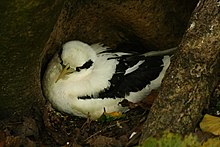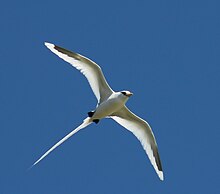White-tailed tropicbird
| White-tailed tropicbird | |
|---|---|
 | |
Conservation status | |
 Least Concern (IUCN 3.1)[1] | |
Scientific classification | |
| Kingdom: | Animalia |
| Phylum: | Chordata |
| Class: | Aves |
| Order: | Phaethontiformes |
| Family: | Phaethontidae |
| Genus: | Phaethon |
| Species: | P. lepturus |
Binomial name | |
Phaethon lepturus Daudin, 1802 | |
The white-tailed tropicbird (Phaethon lepturus) is a tropicbird. It is the smallest of three closely related seabirds of the tropical oceans and smallest member of the order Phaethontiformes. It is found in the tropical Atlantic, western Pacific and Indian Oceans. It also breeds on some Caribbean islands, and a few pairs have started nesting recently on Little Tobago, joining the red-billed tropicbird colony. In addition to the tropical Atlantic, it nests as far north as Bermuda, where it is locally called a "longtail".[2]
Contents
1 Taxonomy
2 Description
3 Behavior
4 Conservation status
5 Folklore
6 References
7 Further reading
8 External links
Taxonomy

Flying at Midway Atoll
There are six subspecies:
P. l. lepturus—Indian Ocean
P. l. fulvus (golden bosun)—Christmas Island. This form has a golden wash to the white plumage
P. l. dorotheae—tropical Pacific
P. l. catesbyi—Bermuda and Caribbean
P. l. ascensionis—Ascension Island
P. l. europae—Europa Island, s. Mozambique Channel
Description

Flying individual
The adult white-tailed tropicbird is a slender, mainly white bird, 71–80 cm long including the very long central tail feathers, which double its total length. The wingspan is 89–96 cm. The bird has a black band on the inner wing, a black eye-mask, and the bill is orange-yellow to orange-red.[3] The bill colour, pure white back and black wing bar distinguish this species from red-billed.
The white-tailed tropicbird breeds on tropical islands laying a single egg directly onto the ground or a cliff ledge. It disperses widely across the oceans when not breeding, and sometimes wanders far. It feeds on fish and squid, caught by surface plunging, but this species is a poor swimmer. The call is a high screamed keee-keee-krrrt-krrt-krrt. Sexes are similar, although males average longer tailed, but juveniles lack the tail streamers, have a green-yellow bill, and a finely barred back. The white-tailed tropicbird does not have a yearly breeding cycle; instead breeding frequency depends on the climate and availability of suitable breeding sites. The bird can reproduce 10 months after the last successful breeding, or 5 months after an unsuccessful one.
Behavior

Pairs in Flight

In the Seychelles
White-tailed tropicbird feeds mainly on flying fish, squid and crabs. It catches its preys by diving from height of up to 20 meters, as gannets. However, flying fish is caught in flight. It usually feeds sometimes in pairs. Prey is often detected by hovering above the surface as the bird swallows it before to take off.[4]

Phaethon lepturus egg, MHNT
Conservation status
Although their population trends are unknown. In Mexico it is not under some category of protection and no specific conservation programs for these tropicbird are known, the species is found in various conservation programs as the American waterfowl. It is recommended to conduct studies on the biology of this species at sea, as well as monitoring of breeding colonies, Globally it is considered a species of Least Concern.[5]
Folklore
The ancient Chamorro people called the white-tailed tropicbird utak or itak, and believed that when it would scream over a house it meant that someone would soon die or that an unmarried girl was pregnant. Its call would kill anyone who didn't believe in it. Chamorro fishermen would find schools of fish by watching them.[6]
References
^ BirdLife International (2017). "Phaethon lepturus (amended version of 2016 assessment)". The IUCN Red List of Threatened Species. 2017: e.T22696645A111235714. Retrieved 12 September 2018..mw-parser-output cite.citation{font-style:inherit}.mw-parser-output .citation q{quotes:"""""""'""'"}.mw-parser-output .citation .cs1-lock-free a{background:url("//upload.wikimedia.org/wikipedia/commons/thumb/6/65/Lock-green.svg/9px-Lock-green.svg.png")no-repeat;background-position:right .1em center}.mw-parser-output .citation .cs1-lock-limited a,.mw-parser-output .citation .cs1-lock-registration a{background:url("//upload.wikimedia.org/wikipedia/commons/thumb/d/d6/Lock-gray-alt-2.svg/9px-Lock-gray-alt-2.svg.png")no-repeat;background-position:right .1em center}.mw-parser-output .citation .cs1-lock-subscription a{background:url("//upload.wikimedia.org/wikipedia/commons/thumb/a/aa/Lock-red-alt-2.svg/9px-Lock-red-alt-2.svg.png")no-repeat;background-position:right .1em center}.mw-parser-output .cs1-subscription,.mw-parser-output .cs1-registration{color:#555}.mw-parser-output .cs1-subscription span,.mw-parser-output .cs1-registration span{border-bottom:1px dotted;cursor:help}.mw-parser-output .cs1-ws-icon a{background:url("//upload.wikimedia.org/wikipedia/commons/thumb/4/4c/Wikisource-logo.svg/12px-Wikisource-logo.svg.png")no-repeat;background-position:right .1em center}.mw-parser-output code.cs1-code{color:inherit;background:inherit;border:inherit;padding:inherit}.mw-parser-output .cs1-hidden-error{display:none;font-size:100%}.mw-parser-output .cs1-visible-error{font-size:100%}.mw-parser-output .cs1-maint{display:none;color:#33aa33;margin-left:0.3em}.mw-parser-output .cs1-subscription,.mw-parser-output .cs1-registration,.mw-parser-output .cs1-format{font-size:95%}.mw-parser-output .cs1-kern-left,.mw-parser-output .cs1-kern-wl-left{padding-left:0.2em}.mw-parser-output .cs1-kern-right,.mw-parser-output .cs1-kern-wl-right{padding-right:0.2em}
^ Longtail. The Bermuda Audubon Society.
^ Redman, Nigel; Stevenson, Terry; Fanshawe, John (2016). Birds of the Horn of Africa: Ethiopia, Eritrea, Djibouti, Somalia, and Socotra - Revised and Expanded Edition. Princeton Field Guides. Princeton, New Jersey: Princeton University Press. p. 42. ISBN 978-0-691-17289-7. OCLC 944380248. Retrieved 2018-11-27.
^ "White-tailed Tropicbird". www.oiseaux-birds.com.
^ "White-tailed Tropicbird – Conservation – Neotropical Birds Online". neotropical.birds.cornell.edu.
^ Cunningham, Lawrence J. (1992). Ancient Chamorro Society. Bess Press. p. 112.
Further reading
ffrench, Richard (1991). A Guide to the Birds of Trinidad and Tobago (2nd ed.). Comstock Publishing. ISBN 0-8014-9792-2.
Harrison, Peter (1996). Seabirds of the World. Princeton: Princeton University Press. ISBN 0-691-01551-1.
External links
| Wikimedia Commons has media related to Phaethon lepturus. |
Wikispecies has information related to Phaethon lepturus |
- Species information on P.l. catesbyi
White-tailed tropicbird videos, photos & sounds on the Internet Bird Collection